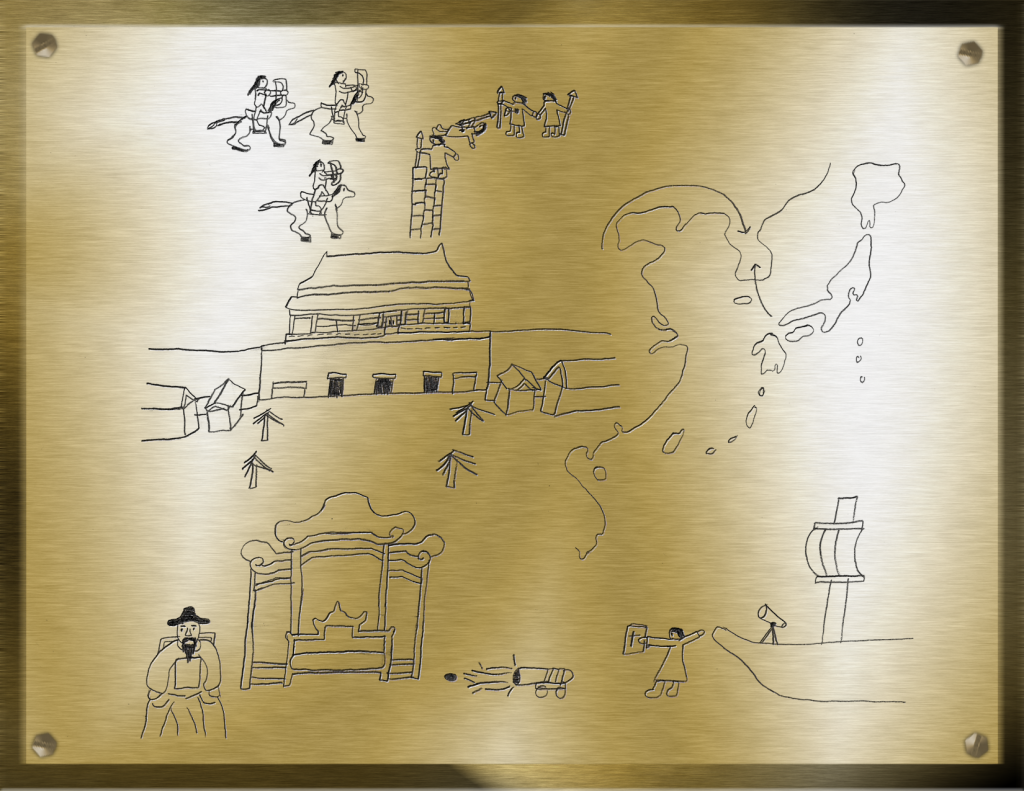
| Time Period | Ming Dynasty in Decline |
| Geographical Region | China in general |
| List of Symbols |
|
The battle between the Chinese and Mongols represents the Chinese expeditions into Mongolia during the Ming dynasty, which usually did not end well for the Chinese. On one of these expeditions the Zhengtong emperor himself was captured by the Mongols. Instead of paying a ransom to get him back, a new emperor was selected. The Mongols eventually sent the captive emperor back, where he was placed under house arrest but eventually was able to seize power again. The Great Wall serves to help identify the time period because the Great Wall made of stone was connected and finished in the Ming dynasty.
It also shows a Mongol outside of it and a Chinese soldier on it to represent that the wall was meant to keep the Mongols out of China. The Forbidden City represents the fact that it was built during the Ming dynasty and also that the capital was moved to the north, near the border with the Mongols, by the Yongle emperor. The proximity of the capital to Mongolia made defending against the Mongols one of the top goals of the Ming dynasty. The Ming allowed the Manchus to gain territory and power in the hopes that they would help fight the Mongols. The Manchus eventually took over China after they were invited in to stop a rebellion. The empty Ming throne represents the lack of good emperors in general and more specifically the Wanli emperor who went on strike and refused to attend court sessions or issue edicts. There were emperors who did not say a single word during court meetings, stopped going to court meetings because they were trying to achieve immortality, and focused more on carpentry than running the empire. The official next to the throne shows that the officials continued to run the government without the emperor. The map of the Japanese invasion of Korea shows the Japanese forces landing in Korea and the Chinese forces moving into Korea to confront them. The Jesuits arrive in a boat and bring a telescope and cannon. The telescope represents the Jesuit’s knowledge of astronomy, which they will use to gain a privileged position in the Imperial Bureau of Astronomy, and the cannon represents the fact that the Jesuits helped design and make cannon for the emperor. The expeditions to Mongolia and the Japanese invasion show that the late Ming dynasty was militarily active, though their performance in both was severely lacking. The Jesuits show the increasing contact China was beginning to have with the West and also the superiority of western science and technology.
The empty throne and official show that the Ming dynasty moved forward without effective leadership, only able to maintain the status quo. Overall, the plaque shows the Ming dynasty in a state of decline, with military failures, invasion by a country much smaller than it, the arrival of foreigners with advanced technology and knowledge, and a string of terrible emperors who created a corrupt and ineffective government. The Ming obsession with the Mongols blinded them to the threat of the Manchus and, when a rebellion threatened the existence of the Ming dynasty, the Manchus were invited in to put down the rebellion. The Manchus then decided to conquer China and proclaimed the next and final Chinese dynasty, the Qing.
NATHAN CHARISSIS is a freshman at the University of Rochester and is majoring in History and Linguistics. He lives in the suburbs of Rochester and likes to play strategy games in his free time.
